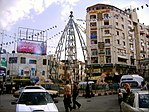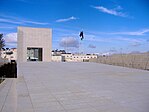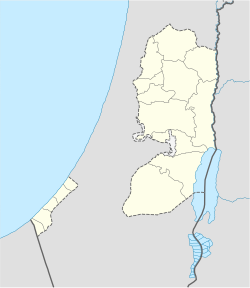拉姆安拉 - 维基百科,自由的百科全书
| 拉姆安拉 拉姆安拉 | |
|---|---|
| A類直轄市 | |
| 阿拉伯語轉寫 | |
| • 阿拉伯文 | رامالله |
從頂端起順時針: 拉馬拉天際線及中央清真寺、阿拉法特墓、聖母領報教堂、羅馬遺跡、阿爾馬娜拉廣場 | |
拉馬拉在巴勒斯坦國的位置 | |
| 坐标:31°54′N 35°12′E / 31.900°N 35.200°E | |
| 巴勒斯坦網格 | 168/145 |
| 國家 | |
| 省 | 拉馬拉和比雷赫省 |
| 政府 | |
| • 类型 | 市(1995年起) |
| • 市長 | Musa Hadid |
| 面积 | |
| • 总计 | 16,344 杜纳亩s(16.3 平方公里 或 6.3 平方英里) |
| 人口(2017年) | |
| • 總計 | 38,998人 |
| • 密度 | 2,393人/平方公里(6,197人/平方英里) |
| 網站 | www.ramallah.ps |

拉姆安拉,又译拉马拉(阿拉伯语:رامالله,羅馬化:ⓘ,直译:真主的高度[1])是巴勒斯坦國的實際首都[註 1],位於約旦河西岸拉姆安拉和比雷赫省,東耶路撒冷以北約10公里。拉姆安拉是巴勒斯坦民族权力机构總部所在地,也是大多數國家駐巴勒斯坦外交機構所在地。
歷史
[编辑]拉姆安拉作为现代城市的历史可追溯至16世纪,而此地也有更早时期的考古遗迹。
公元前
[编辑]拉姆安拉附近有发现古代墓穴。[2]拉姆安拉以南的納斯貝泉堆丘考古遗址有可能是《圣经》中本杰明米斯巴的所在地。[3]当地也有一些砖石结构建筑,可追溯至大希律王统治时期。[3]
十字军东征时期
[编辑]当地有发现十字军时期的陶片。[4]拉姆安拉是十字军驻地之一,当时名为拉马利(Ramalie)。[5][6]当地亦有发现一座十字军时代的拱形门廊建筑,其用途尚不确定。[7]
奥斯曼帝国时期
[编辑]1517年,拉姆安拉随整个巴勒斯坦一起并入奥斯曼帝国。现代拉姆安拉城市由哈达丁家族于16世纪中期建立,该家族由加桑尼德基督徒后裔组成。哈达丁家族原本生活在约旦河以东的卡拉克和舒巴克地区,后因战乱迁徙至此。[8]
拉姆安拉的山区地形与哈达丁家族原本的栖息地相似,吸引了哈达丁家族前来定居。此外,拉姆安拉森林茂密,为哈达丁家族提供了充足的燃料用于锻造。[8]在1596年的税务登记册中,拉姆安拉被列为圣城耶路撒冷的分区。当地有71户基督徒家庭和9户穆斯林家庭。政府对当地小麦、大麦、橄榄和葡萄树等作物征收25%的固定税额。[9]
1838年,美国圣经学者爱德华·罗宾逊访问拉姆安拉,称当地居民为“有希腊礼仪的基督徒”。当地有200名纳税男性,据此估计当时总人口为800-900人。[10]
1883年,《西巴勒斯坦调查》一书对拉姆安拉的记录如下:
(当地是)一座大型基督教村庄,矗立在高耸的山脊上,有许多精心建造的石屋,向西望去可见到大海。当地坐落于花园和橄榄园当中,南面有三处泉水,西面有一处泉水。北面还有三处泉水,距离村庄不到一英里。东面有一口井。东北方向有岩石凿成的坟墓,入口凿得很精巧,但完全被垃圾堵住了。村里有一座希腊教堂,东边有一座拉丁修道院和一所新教校舍,都是现代建筑。村庄的土地是教会财产,属于耶路撒冷圣地。大约四分之一的居民是罗马天主教徒,其余的是希腊东正教教徒。[11]
1948年以色列立國後,離開以色列領土的難民令拉姆安拉的人口在5年內增加了一倍,但同時有約三分一的原居民移民到美國,發展成為美國國內最大阿拉伯裔社群之一。拉姆安拉在第一次中東戰爭後被約旦吞併,居民成為約旦公民。拉姆安拉在1967年六日戰爭後被以色列軍事佔領,以色列人在附近建立的定居點限制了拉姆安拉的發展。以軍直至1995年始撤出市中心,讓巴勒斯坦自治政府進駐,但在外圍保留據點。
2000年開始的新一輪以巴衝突,令拉姆安拉的經濟急速惡化,居民生活也大受影響。
在2004年去世的巴勒斯坦民族權力機構前主席阿拉法特葬於拉姆安拉。
经济
[编辑]註釋
[编辑]參考文獻
[编辑]- ^ "Ramallah.ps". Ramallah.ps. Archived from the original on November 5, 2011. Retrieved November 13, 2011.
- ^ Conder, C.R.; Kitchener, H.H. (1883). The Survey of Western Palestine: Memoirs of the Topography, Orography, Hydrography, and Archaeology. Vol. 3. London: Committee of the Palestine Exploration Fund, p.155
- ^ 3.0 3.1 "Ramallah | town, West Bank | Britannica". www.britannica.com. Archived from the original on June 27, 2022. Retrieved June 10, 2022.
- ^ Finkelstein, I.; Lederman, Zvi, eds. (1997). Highlands of many cultures. Tel Aviv: Institute of Archaeology of Tel Aviv University Publications Section. ISBN 965-440-007-3. Archived from the original on August 10, 2020. Retrieved January 3, 2019.
- ^ Rey, E.G. [in French] (1883). Les colonies franques de Syrie aux XIIme et XIIIme siècles (in French). Paris: A. Picard.
- ^ Prawer and Benvenisti, 1970, cited in Finkelstein and Lederman, 1997, p. 353
- ^ Pringle, D. (1997). Secular buildings in the Crusader Kingdom of Jerusalem: an archaeological Gazetteer. Cambridge University Press. ISBN 0521-46010-7. Archived from the original on June 8, 2020. Retrieved November 15, 2015.
- ^ 8.0 8.1 "American Federation of Ramallah Palestine". Archived from the original on October 29, 2008.
- ^ Hütteroth, Wolf-Dieter; Abdulfattah, Kamal (1977). Historical Geography of Palestine, Transjordan and Southern Syria in the Late 16th Century. Erlanger Geographische Arbeiten, Sonderband 5. Erlangen, Germany: Vorstand der Fränkischen Geographischen Gesellschaft. ISBN 3-920405-41-2. Archived from the original on October 14, 2019. Retrieved December 10, 2018.
- ^ Robinson, E.; Smith, E. (1841). Biblical Researches in Palestine, Mount Sinai and Arabia Petraea: A Journal of Travels in the year 1838. Vol. 2. Boston: Crocker & Brewster.
- ^ Conder, C.R.; Kitchener, H.H. (1883). The Survey of Western Palestine: Memoirs of the Topography, Orography, Hydrography, and Archaeology. Vol. 3. London: Committee of the Palestine Exploration Fund.


 French
French Deutsch
Deutsch




